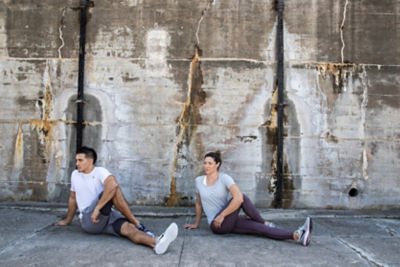How to Choose the Right Cross Country Shoes
Your footwear can make or break a race. Make sure you go the extra mile with the best pair of cross country shoes for you.

On the cross country course, runners are competitive athletes with a singular focus of running the best possible time. To do so, they need the highest quality gear they can get. Therefore, it is impossible to overstate the importance of the shoes a competitive cross country runner selects. Choosing the right shoes can factor into the overall success of a cross country season. So here are a few things to consider when looking for your most important equipment.
1. HAPPY TRAILS TO YOU
Most cross country courses consist of well-maintained and manicured trails and grass. Think golf courses and public parks. These courses are often more technically difficult than a track or sidewalk due to roots and rocks and other tricky natural obstacles. So most cross country teams train on similar terrain, which means you’ll need a pair of shoes specialized to handle these rigors. Luckily, the growth of trail running in the past 25 years means that there are plenty of choices when it comes to trail shoes. However, if your training consists of running on paved roads and walkways, like in urban environments, road-running shoes may very well be a viable option.
2. ’TIS THE SEASON
You are buying these shoes to run for miles and miles; you are not — repeat not — selecting a shoe for the long haul in terms of calendar time. You are training for an athletic season the same as any baseball, football or volleyball player. Consider your shoes accordingly. These shoes will be your best friend for the next three to four months before being relegated to lawn-mowing duties next summer. That means they should be lightweight enough to handle speed and sprinting workouts and padded enough to handle those endurance-building long runs.
3. OPEN THE GAIT
Most specialty retailers will have the specialized equipment and sales associates to properly determine your level of pronation. If you overpronate or underpronate, you might want to consider a stability shoe. If not, a neutral shoe will do just fine. Inquire with a sales associate and ask if they do gait analysis.
If visiting a store isn’t a possibility, look at your current shoes. Any pair will do, but if you have a pair of shoes you already run in, that would be the pair to examine. Set them on a flat surface and look at them from behind. Do they lean one way or the other, or do they sit relatively flat? Now examine the sole. Where is the tread most worn? Where is the foam most compressed? In both cases, if it’s on the extreme outside or inside of the foot, you are likely an overpronator or underpronator and might want to get a pair of lightweight stability shoes.
4. FOCUS ON FLEXIBILITY
So far, we’ve narrowed the selection to a lightweight trail shoe that matches your gait and we haven’t even touched a shoe. But now it’s time to do just that.
Move to the rack and find a likely shoe. Admire its sleek lines, construction and tread. Think of how this is going to cocoon your foot and protect it from harm. Then grab it by the heel, place the toe against the floor and try to push it through the floor. Does it bend where it would flex if you’re wearing it? Does it remain rigid from the midfoot portion to heel? Yes on both counts? Good. It’s a viable candidate. If not, put it back. It’s not the right shoe for you.
5. TRY IT ON
Put the shoes on and tie both of them. Make sure there is a thumbnail’s worth of space between your toe and the front of the shoe.
(Pro Tip: the best time to try on running shoes is after a run because feet swell and spread out during exercise. Trying them on at this time will give you a more accurate fit).
Then, try them out by jogging down the aisle of the store. If they are comfortable, then answer one simple question: How do they feel? Comfy? If the answer is yes, then good, they are a viable candidate.
6. GO FOR FUNCTION OVER FASHION
Listen, we all want to be the coolest cat around and the selection of our athletic gear should be a reflection of our undeniable coolness, right? Wrong. What good will it do if they look great while you’re standing still, but don’t allow you to move as fast as you can? Try all brands and styles of shoes that meet your requirements and try them on with your eyes closed. Pick the one that feels the best.
7. REPEAT AFTER ME
Most cross country athletes opt for two pairs of shoes: trainers and racers. And in case it’s not painfully obvious, trainers are used in day-to-day training while racers are held in reserve for race day. Racers sacrifice padding for performance by shedding weight. In doing so, runners are able to quicken and lengthen their stride, thus running faster times. They also usually feature interchangeable spikes or rubber stubs that help a runner dig in and gain traction. These differences aside, there are few differences in selecting a trainer versus a racer. But since it’s the trainer that’s the real workhorse, that’s the shoe most runners focus on when selecting a pair of shoes. Simply repeat the process for your racers.
And that’s it. Now you have the shoes that will carry you through the season.
Searching for the right size? Look for the True Fit icon on apparel and footwear product pages when shopping online at DICK’S Sporting Goods. Get personalized size and fit recommendations with just a few clicks. Learn more about True Fit.







